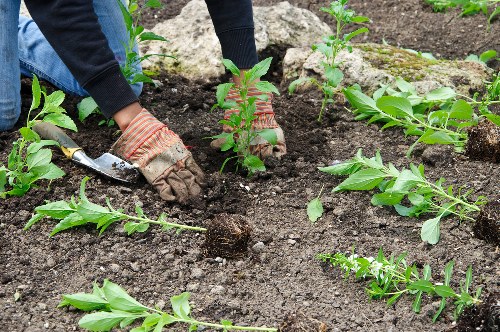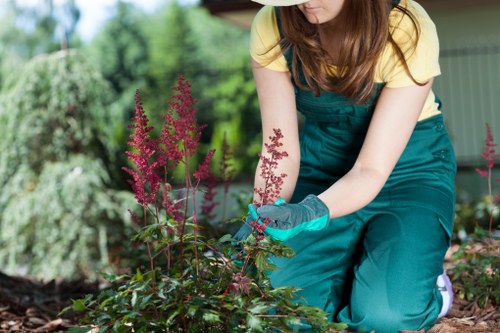Mastering Hedge Trimming in Dulwich: Your Comprehensive Guide
Introduction to Hedge Trimming in Dulwich

Maintaining beautiful hedges is an essential aspect of garden care, especially in areas like Dulwich where lush greenery is highly appreciated. Hedge trimming in Dulwich not only enhances the aesthetic appeal of your property but also promotes the health and longevity of your hedges.
In this guide, we will explore everything you need to know about hedge trimming, from the benefits and techniques to the best times of year for maintenance. Whether you’re a seasoned gardener or a homeowner looking to enhance your outdoor space, this article will provide valuable insights.
Understanding the importance of proper hedge trimming can transform your garden, making it a vibrant and inviting space for relaxation and enjoyment.
The Benefits of Regular Hedge Trimming

Regular hedge trimming offers numerous advantages that go beyond mere aesthetics. One of the primary benefits is the promotion of healthy growth. By trimming away dead or overgrown branches, you allow more sunlight and air to reach the inner parts of the hedge, which is crucial for its overall health.
Moreover, well-maintained hedges serve as effective barriers, providing privacy and shielding your property from unwanted noise and wind. In Dulwich, where properties often feature elegant gardens, neatly trimmed hedges can significantly enhance curb appeal and property value.
Additionally, regular trimming helps in shaping the hedge, ensuring it grows in a balanced and pleasing manner. This not only makes your garden look well-kept but also makes the maintenance process easier in the long run.
Types of Hedges Common in Dulwich

Dulwich boasts a variety of hedge types, each suited to different garden styles and maintenance levels. Some of the most popular hedges include boxwood, privet, and yew.
- Boxwood: Known for its dense foliage and ability to be easily shaped, making it ideal for formal gardens.
- Privet: Fast-growing and versatile, privet hedges are excellent for creating privacy screens.
- Yew: Highly resilient and slow-growing, yew hedges are perfect for long-lasting boundaries.
Choosing the right type of hedge depends on your specific needs, such as the desired height, growth rate, and maintenance commitment. Consulting with local gardening experts in Dulwich can help you make an informed decision.
When and How to Trim Your Hedges

Timing is crucial when it comes to hedge trimming. In Dulwich, the best times to trim hedges are typically in late spring and late summer. Trimming during these periods encourages healthy growth and prevents the hedge from becoming too unruly.
- Late Spring (May-June): This is the ideal time to shape your hedges and remove any dead or damaged branches.
- Late Summer (August-September): A second trimming helps maintain the desired shape and prevents the hedge from becoming too dense.
When trimming, always ensure you use the right tools and techniques. Start by removing any diseased or damaged branches, then proceed to shape the hedge evenly. For best results, make clean cuts at a slight angle to promote faster healing.
Essential Tools and Equipment for Hedge Trimming

Having the right tools is essential for effective hedge trimming. Some of the must-have equipment includes:
- Pruning Shears: Perfect for small branches and precise trimming.
- Hedge Trimmers: Ideal for larger hedges, providing uniform cuts quickly.
- Loppers: Useful for cutting thicker branches that pruning shears can’t handle.
- Protective Gear: Gloves, safety goggles, and protective clothing to ensure your safety while trimming.
Regular maintenance of these tools, such as sharpening blades and cleaning after use, ensures longevity and effectiveness. Investing in high-quality equipment can make the hedge trimming process more efficient and less labor-intensive.
Professional Hedge Trimming Services vs. DIY
Deciding between hiring a professional hedge trimming service in Dulwich and undertaking the task yourself depends on several factors. Professional services offer expertise, efficiency, and high-quality results, especially for large or complex hedges.
On the other hand, DIY hedge trimming can be more cost-effective and allows for greater flexibility in scheduling. However, it requires the right tools, knowledge, and time commitment.
Consider your personal gardening skills, the size of your hedges, and the amount of time you can dedicate to maintenance before making a decision. For optimal results, especially for intricate designs or large properties, professional services are often the preferred choice.
Best Practices for Maintaining Healthy Hedges
Maintaining healthy hedges goes beyond regular trimming. Here are some best practices to ensure your hedges thrive:
- Proper Watering: Ensure your hedges receive adequate water, especially during dry spells.
- Fertilization: Apply suitable fertilizers to promote robust growth and vibrant foliage.
- Pest and Disease Control: Regularly inspect your hedges for signs of pests or diseases and take prompt action if needed.
- Mulching: Apply mulch around the base of the hedges to retain moisture and suppress weed growth.
Implementing these practices will help maintain the health and appearance of your hedges, making future trimming sessions more manageable and effective.
Environmental Considerations in Hedge Trimming
When trimming hedges in Dulwich, it’s important to consider the environmental impact of your actions. Sustainable practices can help preserve the local ecosystem and promote biodiversity.
Use environmentally friendly tools and avoid chemical pesticides or fertilizers that can harm beneficial insects and wildlife. Instead, opt for organic alternatives and natural pest control methods.
Additionally, consider the timing of your trimming activities to avoid disturbing nesting birds or other wildlife that may rely on your hedges for shelter.
Seasonal Hedge Trimming Tips
- Spring: Focus on shaping and encouraging new growth.
- Summer: Maintain the shape and remove any overgrown sections.
- Autumn: Prepare the hedges for winter by trimming back to protect against frost damage.
- Winter: Minimal trimming is required, but inspect for any damage caused by harsh weather.
Adapting your hedge trimming routine to the changing seasons ensures that your hedges remain healthy and visually appealing year-round.
By following these seasonal tips, you can effectively manage your hedges and address any specific needs that arise throughout the year.
Choosing the Right Hedge Trimming Service in Dulwich
Selecting a reliable hedge trimming service in Dulwich involves considering several key factors. Start by researching local providers and reading reviews to gauge their reputation and quality of work.
Ensure that the service you choose is experienced in handling the specific type of hedges you have. Ask about their trimming techniques and whether they adhere to sustainable practices.
Additionally, compare quotes from multiple providers to ensure you’re getting value for your money. Don’t hesitate to ask for references or examples of previous work to ensure their expertise matches your expectations.
Cost Considerations for Hedge Trimming
The cost of hedge trimming in Dulwich can vary based on several factors, including the size and height of the hedges, the complexity of the job, and whether you choose a professional service or opt for DIY.
Professional services typically charge based on the time and resources required to complete the job efficiently. While this may be more expensive upfront, it often results in higher quality and more consistent results.
On the other hand, DIY trimming can save money but requires investment in tools and time. Consider the long-term benefits and potential cost savings when making your decision.
Common Mistakes to Avoid in Hedge Trimming
- Over-Trimming: Cutting too much can stress the hedge and hinder its growth.
- Improper Tool Use: Using dull or inappropriate tools can damage the hedge and lead to irregular growth.
- Ignoring Seasonal Timing: Trimming at the wrong time of year can negatively impact the health of the hedge.
- Neglecting Regular Maintenance: Infrequent trimming can make the task more challenging and less effective.
Avoiding these common mistakes ensures that your hedge trimming efforts are beneficial and contribute to the overall health and beauty of your garden.
By staying informed and adhering to best practices, you can maintain stunning hedges that enhance your Dulwich property.
Enhancing Your Garden with Well-Trimmed Hedges
Well-trimmed hedges play a crucial role in defining the structure and aesthetics of your garden. They can be used to create distinct areas, provide privacy, and add vertical interest to your landscape.
In Dulwich, where garden design is often a reflection of personal style, neatly maintained hedges can complement various themes, from classic and formal to modern and informal.
Incorporate a mix of different hedge types and heights to add depth and variety to your garden, making it a picturesque and harmonious space.
Innovative Hedge Trimming Techniques
Exploring innovative trimming techniques can elevate the appearance of your hedges and make the maintenance process more efficient. Some advanced methods include:
- Topiary: Sculpting hedges into artistic shapes and designs, adding a unique visual element to your garden.
- Heading Back: Cutting back the branches to encourage dense and bushy growth.
- Selective Pruning: Removing specific branches to enhance the overall structure and health of the hedge.
Experimenting with these techniques can transform your hedges into stunning focal points, showcasing your creativity and enhancing the overall garden design.
Consulting with professional hedge trimmers can provide you with insights and expertise to implement these techniques effectively.
Maintaining Long-Term Hedge Health
Long-term hedge health requires consistent care and attention. Regular trimming, combined with appropriate watering, fertilization, and pest control, ensures that your hedges remain robust and vibrant.
Monitor your hedges regularly for any signs of stress, disease, or pest infestation. Early detection and intervention can prevent minor issues from escalating into major problems.
Additionally, rotating fertilizers and using diverse plant species can reduce the risk of soil depletion and promote a balanced ecosystem within your garden.
Conclusion and Call to Action
Hedge trimming in Dulwich is a vital aspect of garden maintenance that enhances both the beauty and health of your outdoor space. Whether you choose to undertake the task yourself or hire a professional service, understanding the key principles and best practices will ensure successful results.
By investing time and effort into proper hedge care, you can enjoy a stunning and thriving garden that stands out in the charming neighborhood of Dulwich.
Ready to transform your garden with expertly trimmed hedges? Contact us today to schedule your hedge trimming service and experience the difference professional care can make.
